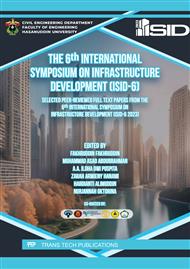p.3
p.13
p.21
p.37
p.47
p.57
p.65
p.75
Modeling of Flood Prone Areas in the Remu Watershed
Abstract:
Indonesia is an archipelagic nation situated geographically at the intersection of two continental plates and on the equator. Consequently, Indonesia has a tropical climate and varied precipitation. Due to the country's strategic location, it receives numerous advantages, however there are also negative consequences, including the flood calamity. This study's objective was to investigate the parameters that influence the hydrology and characteristics of the upstream watershed so that the results can be used as a reference when developing models for flood disaster mitigation. This study employs quantitative methodology. The data used are both primary and secondary, consisting of field surveys and river topography and rainfall data from the BMKG post, respectively. Climate change is one of the parameters that affect hydrology. Climate change has a significant impact on the increase in rainfall, which can lead to flooding in the Remu river basin (Das). Changes in the characteristics of rain in the Das, such as high annual rainfall and maximal daily rainfall, tend to increase, in addition to the effects of land use, soil type, slope, and riverside residents, resulting in flooding in the Remu Das. The highest discharge occurred at the 2-year return period of 171.50 m3/s, the 5-year return period of 250.28 m3/s, the 10-year return period of 307.26 m3/s, the 25-year return period of 384.61 m3/s, the 50 year birthday of 446.25 m3/s, and the 100 year birthday of 511.38 m3/s. According to the results of the simulation model, the inundation area for a 2-year return period is determined to be 300.98 hectares. The pool area for the 5-year return period is 347.18 ha, for the 10-year return period it is 679.07 ha, for the 25-year return period it is 1,023.88 ha, for the 50-year return period it is 1,295.61 ha, and for the 100-year return period it is 1,547.14 ha. In order to combat flooding, non-structural methods, such as the flood forecasting and warning system (FFWS), where the principle of FFWS is to carry out forecasting, detection, early warning systems and flood information management systems. This is done to reduce the impact of flood hazards on the Remu watershed.are required. The magnitude of flooding in the Remu watershed is significantly affected by the potential for climate change and alterations in watershed characteristics, according to the findings of this study. In addition, to enhance the accuracy of the flood forecasting warning system in the Remu Basin, the locations of the Rainfall Post and Water Estimation Post must be added.
Info:
Periodical:
Pages:
37-46
Citation:
Online since:
July 2025
Keywords:
Price:
Сopyright:
© 2025 Trans Tech Publications Ltd. All Rights Reserved
Share:
Citation:


